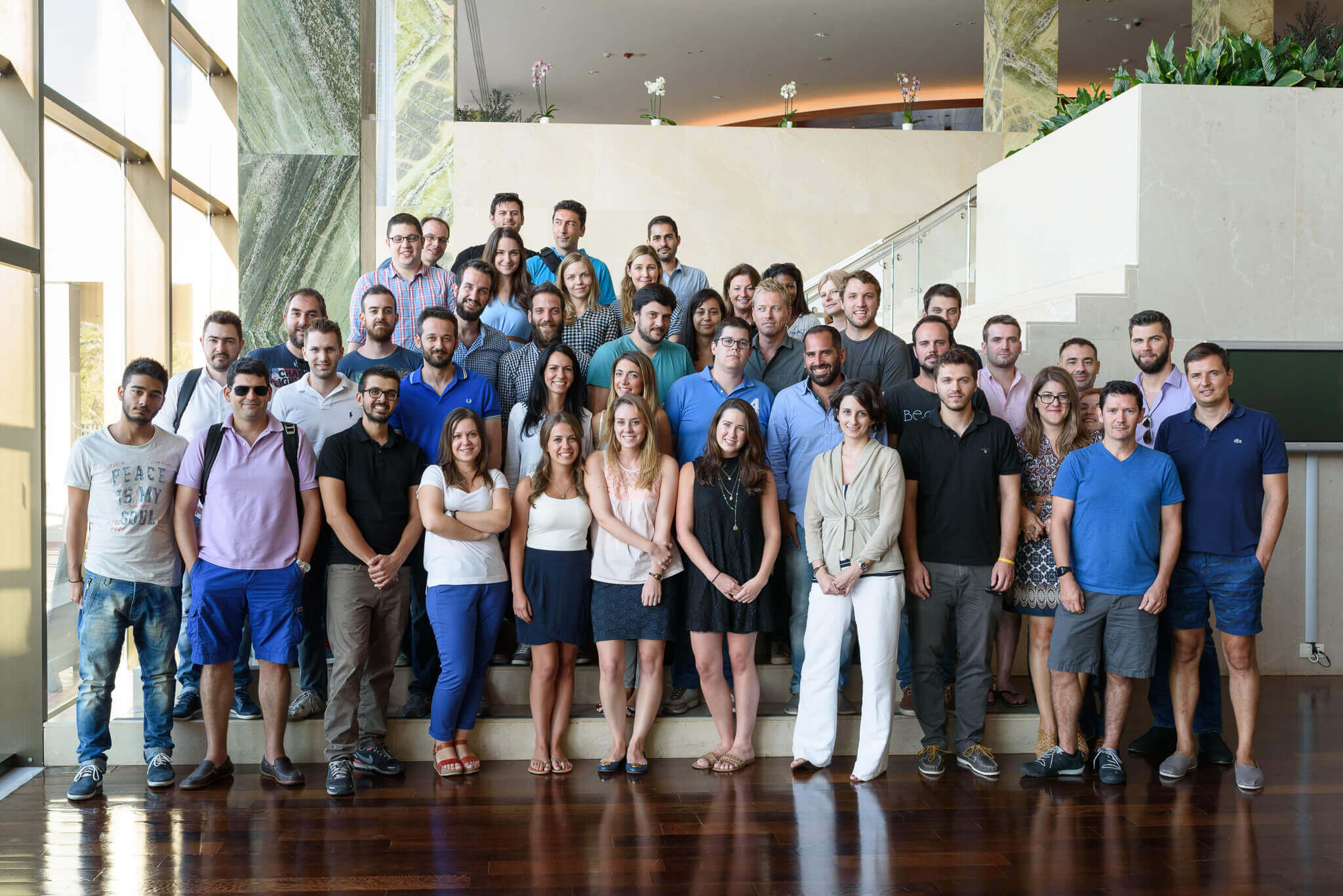Lessons from a distributed team
Like a lot of its peers Workable began life as a fully distributed team. The two founders, Nikos Moraitakis and Spyros Magiatis worked from their respective homes in Athens, Greece. Their first collaborator was the brilliant designer, Zaharenia Atzitzikaki, known to everyone as “Sugar”, who works from her home on the island of Crete, which is about as far south as Europe goes.

Note: This was written and published in February 2016. Workable is now upwards of 220 full-time employees with its own office in Boston’s Financial District as well as in Athens, London, and Sydney. The can-do spirit still lives, and the lessons herewithin still apply today, so we’re leaving this as is. Enjoy!
Three years later, the Workable virtual teams are fast approaching 80 people. Nikos, our CEO, is in Boston, where the team is packing up their rooms at WeWork and moving into dedicated offices nearby in Fort Point. Spyros, our CTO, is still in Athens but would struggle to fit the by now 40-strong engineering team into his apartment. Rapid growth means we no longer even fit in the nice two-story office we moved into only 18 months ago. We move into a bigger space in April. Sugar, who now has a whole team supporting her, still works from her place on Crete.
Workable also has a London office, which has been home to our creative director and the head of sales but now has a bit of data science as well. And this is not to forget our sales and support virtual teams who have a rugged outpost in Portland, Oregon and are looking for someone special in Australia.
In other words, while we’re developing around two main hubs, we have learned some distributed team best practices and keys for managing virtual teams.
Remotely feasible
We need to be clear what we mean when we talk about remote working and distributed teams because people talk a lot about them and they often mean sharply different things. Usually, they are talking about:
- Fully distributed teams: companies with no offices, notable examples being Buffer and Automattic. Because fully distributed teams are rare, they’re noteworthy. But true digital nomads remain a much-discussed and relatively small tribe.
- Partially distributed teams: have a main hub or hubs but employ a proportion of remote workers.
Workable belongs to the second of these and is significantly invested in two main hubs in the US and Greece. This isn’t because the old challenges of working away from the office have defeated us. From a technological and management standpoint, the problems associated with virtual teams have largely been solved in the last ten years.
A culture that sticks

Distributed work is something we thought hard about at Workable. And we concluded that we were getting value from a bricks and mortar office. We decided that we did want somewhere where people gathered, worked together and got to know each other. This would be central to how we’d establish a culture that was stronger than an idea remembered from an all-hands summit. It would be a place where we would live the rituals and develop the habits that make us feel part of a group.
If that sounds a bit like a home then it’s not an accident. At Workable, the bond between early employees was akin to family, and a family needs a home. Once you’ve built a relationship and trust, more flexible future relationships are possible. We would be unlikely, for instance, to hire someone in Sweden out of the blue. But if someone who has been working for us for two years wanted to move to Sweden then we’d consider it.
We’ve solved how to work effectively with each other regardless of where we are. But getting there would have been a lot harder without the experience of working together from our early Athens hub.
This is the spirit in which we came to Boston. It looks like all you need to do to do is hire a couple of people and rent a desk in a co-working space but that’s wrong. Some of the important early employees need to move there if the culture is to be transplanted effectively and you have to start almost from scratch in building an employer brand. In short, you need some critical mass. It’s more like building an extra company.
Two hubs good, three hubs bad

At one point we had three locations (Athens, London, and Boston), all of which were in the running to be Workable hubs of more than 20 people. But we had to be honest about the impact of spreading our effort across three fronts. The conclusion was that we could manage two hubs that were on a par in terms of what they offered the company and the team, but more than two risked eroding that standard.
At Workable, we can work remotely and some of us do, all or part of the time. We’re not dogmatic about it. Just because we have two hubs now doesn’t mean we can’t afford to make an exception. This is not about purity. But a future in which there were 150 of us all working from home didn’t make sense to us.
Yes, the tools are so much better than they were a decade ago but they don’t fully substitute for presence and proximity. Building a company culture through Google Hangouts and Slack is possible (and kudos to the remarkable companies who have done just this) but you have to want to make this the absolute defining article of your company culture.
For us this essence was the product, not the freedom from location. Nikos is asked sometimes if Workable is an American or a Greek company. His answer is that it’s both, “we are not defined by where we work but what we produce.”
5 tips for virtual teams
1. Get the tools right
Across the company, we rely on simple, affordable and reliable software. For us, this has been an evolving mix which we’ll divide into real-time (remote collaboration, teleconferencing, chat) and asynchronous tools. The main pillars of our real-time work are Slack, Google Docs and Hangouts.
Asynchronous tools are about capturing information about work in online tools so that people can design, implement, or review stuff in their own time. Here’s it’s important to have user-friendly, lightweight tools that people love to use. That enables you to capture as much of the work as possible and prevent remote workers feeling excluded. These include Asana (everyone), Pivotal (engineering), Invision (design), and Pipedrive (sales).
2. Spend time with each other early
Kick start your virtual teams with a real-life gathering. It’s much easier to get an understanding of the way people like to work — and their sense of humor — face to face. As Denise Wilton, our Creative Director explains: “Subtleties can get lost in text chat; that person still hasn’t replied… are they busy, really stuck or annoyed? Should I message them again? Once you get to know people in person it’s a lot easier to judge when a member of your team is struggling and when you can help.”
3. Travel often
Only by being there for an extended amount of time do you get a better sense of the issues and the working conditions of a remote team. Our VP Operations, Thanos Markousis, recalls his Boston team telling him that they sometimes missed out on important developments in Athens, but only when he stayed longer in Boston did he experience feeling a bit cut off himself. The answer was a shared document (which has now evolved into a wiki) where, during the day, the local team enters all noteworthy developments that are happening in the company (e.g. new release coming out, new way to investigate a common customer problem, new information about how something works), and it’s the first thing the Boston team reads when they start their day.
4. Get a schedule that works
Make sure people in separate offices (and different time zones) understand the schedule. John Short, our VP Demand Generation, had to flip his schedule from working by himself in the mornings, with meetings in the afternoon to maximize his overlap with colleagues six times zones away. Understanding and making an effort to actually do this is important.
5. Invest in communication
Using the best equipment for video and voice conferencing is going to pay dividends. At Workable, we have Chromeboxes which enable more effective long distance communication. “I really enjoy staring into a screen, calling out ‘can you hear me,’” said nobody, ever. It’s small things like spending five minutes to set up a meeting and bad connections that cause teams to communicate less when they should be talking more.




